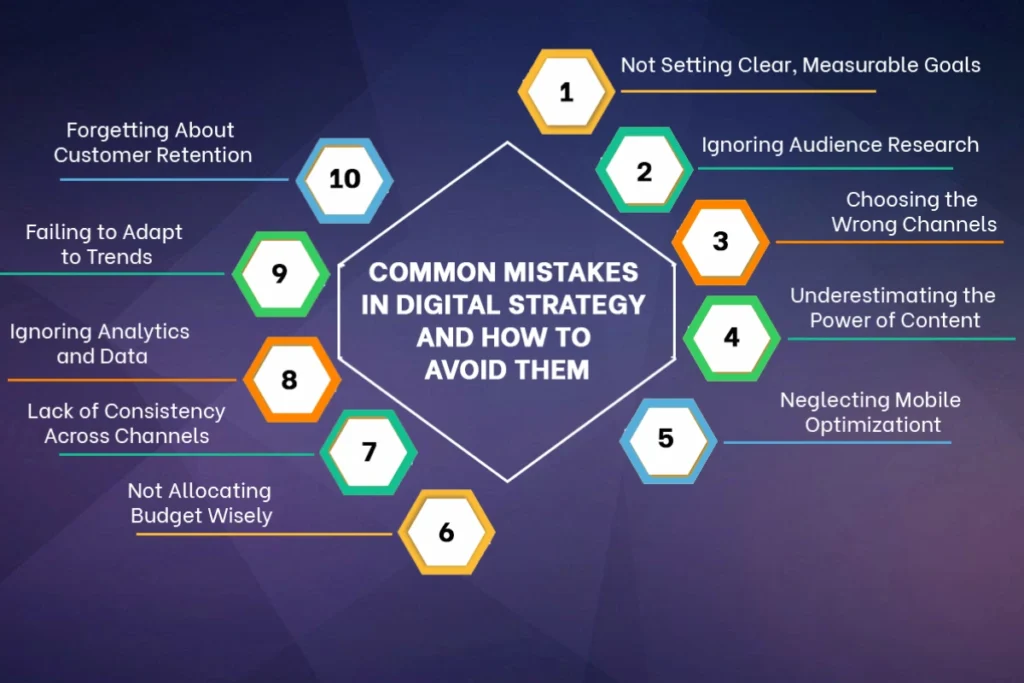
Gist of the Content (Content Summary)
Digital strategy is an essential part of business growth, and while brands need it to grow, they are unwittingly making digital strategy mistakes which cripple performance. A fuzzy goal, misaligned platforms, and other strategy missteps can lead to marketing plan problems that are big. In this guide, we’re going to explore a few digital marketing fails that happen far too often and offer smart, executable advice to avoid making them. No matter how long your brand has been on, you’ll get practical lessons to optimise your strategy and create your resilient online presence.
Introduction
While we’re living in today’s digital first world, it’s not enough to have a digital strategy. Execution and precision define success. Just as there is no substitute for a poor directly implemented strategy, there is no substitute for a brilliant concept poorly implemented. Many times, businesses put in a lot of digital channels only to fail to solve common digital marketing fails.
What is the cost of those strategy missteps? The consequences include wasted budgets, missed growth opportunities, diluted brand impact, and a loss of competitive edge. Digital execution mistakes can produce long term marketing plan issues that have to be fixed there months.
In this article we’re going to dive into the most common mistakes in digital strategy and get smarter on how to avoid marketing mistakes by planning better, analyzing better, and executing better. What we’re going to do is we’re going to equip your business with smarter tools for digital growth.
Common Mistakes in Digital Strategy and How to Avoid Them

1. Not Setting Clear, Measurable Goals
Mistake Explained:
In fact, one of the biggest digital strategy mistakes is starting campaigns without clear objectives. A lot of the time, businesses jump on SEO, paid ads or social media campaigns with an idea like, ‘we need to get more traffic,’ or ‘we need to get more visibility,’ but they don’t really know how to define or measure success. As a result, marketing plan, resource allocation, and evaluation issues unfold.
Real Example:
If a company running Facebook ads doesn’t decide what to count as the conversion goal before diving in (signups, downloads, sales), there is a constant issue getting insights from this spend. With no clarity on this almost high click through rates mean nothing.
How to Avoid:
Adopt SMART goals. For example, “In the next 90 days, grow monthly newsletter subscriptions by 20%.” You’d gain this kind of precision to prevent marketing mistakes and measure your results with accountability. Whenever you create a campaign, make sure always to link the campaign to any specific KPIs like ROI, CTR, bounce rate, or CAC.
2. Ignoring Audience Research
Mistake Explained:
That’s the problem with many brands; they think they already know their customers and consequently, make massive strategy missteps. When looking for data driven insights, marketing is nothing more than guesswork. When nobody resonates with your messages, it results in digital marketing fails and wasted ad spend.
Real Example:
A poor research marketing plan that engaged a luxury brand to market premium products to price sensitive people is a classic marketing issue.
How to Avoid:
Create buyer personas with details about customer segments such as demographics, interests, behaviors, etc and then validate those with customer surveys, CRM data, social media insights, Google Analytics and more. Learn what your audience’s age, preferences, challenges, and purchasing behaviour looks like. It aids you in playing around those mistakes in marketing and discover messaging that will really communicate.
3. Choosing the Wrong Channels
Mistake Explained:
A typical digital strategy mistake is to try to keep presence on all available platforms from Pinterest to even TikTok, while not having strategic alignment. Not all business models, audiences can be accommodated in each channel.
Real Example:
A B2B software company that puts all of its focus on Instagram, never turning its focus to LinkedIn, where decision makers reside, has made a big strategy and engagement mistake.
How to Avoid:
Find out where your crowd is the most alive. Google Analytics, social listening tools, and competitor audits should all be leveraged for insights. While you want to avoid marketing errors, there’s no reason to waste time and fail with marketing plan issues.
4. Underestimating the Power of Content
Mistake Explained:
The best digital marketing fail in the land is treating your content as a secondary effort — by not dedicating a proper budget to it, not hiring experts, settling for inconsistent publishing (or all of the above). In fact, good content is tied to SEO, driving your authority and your leads.
Real Example:
Without a keyword strategy and a call to action, the business that rarely blogs is making digital strategy mistakes that are making it invisible on search engines and irrelevant to prospects.
How to Avoid:
Create business goals within the calendar which aligns them with the desired content. Storytelling, together with SEO rich keyword content and visual assets. Content investing eliminates a number of marketing plan problems and guarantees brand consistency. Don’t forget — content is and will always be evergreen and long term asset, not a one time job.
5. Neglecting Mobile Optimization
Mistake Explained:
If you’re not optimizing for mobile, you’re making significant strategic missteps, considering that over 60% of web traffic is mobile. If your site is slow or doesn’t look good on mobile, users will bail before they interact.
Real Example:
Abandoned carts? They are a common, costly digital marketing fail — for instance, if you’ve got a retail brand with a desktop optimized checkout page but a broken mobile interface.
How to Avoid:
Use responsive web design. Run mobile-friendly test and prioritize page speed. Digital strategy mistakes on a site are picked up before they hurt user experience by tools such as Google PageSpeed Insights and GTmetric. With optimized mobile journeys, you don’t make marketing errors and conversions increase.
6. Not Allocating Budget Wisely
Mistake Explained:
Lots of companies are burning budgets on unproven or too broad campaigns while chasing trends and copying competitors without any context. It causes marketing plan problems and dismal payoffs.
Real Example:
Another digital marketing fail we’ve seen often involves spending 70% of a small marketing budget on influencer partnerships and never tracking ROI.
How to Avoid:
Start small. A/B test campaigns. Spend should be allocated based on real data, not assumptions. By looking at metrics like cost per click and customer acquisition cost you’ll avoid marketing mistakes and scale what’s working only.
7. Lack of Consistency Across Channels
Mistake Explained:
But like classic strategy missteps, messaging, tone and visual branding aren’t consistent across platforms — those things confuse and weaken credibility. A cohesive experience builds brand recognition but also trust in your brand.
Real Example:
When a brand’s content is written on LinkedIn using formal language, yet in email campaigns it uses casual slang, the result is a fragmented identity, which is a common digital strategy mistake.
How to Avoid:
Define tone, color schemes, logos, and create messaging templates for your brand guidelines. So use these across social media, websites, email marketing, and paid ads. Avoiding problems with marketing plan and authority building are a virtue of brand uniformity.
8. Ignoring Analytics and Data

Mistake Explained:
If we make decisions by gut and not verified data, poor outcome results. Not paying attention to analytics possibly is probably the most easily avoidable of digital strategy mistakes — yet many brands make this mistake.
Real Example:
When a business redesigns the layout of its website without viewing heatmaps or user behaviour, conversions go down and that’s a digital marketing fail nobody sees coming.
How to Avoid:
Then track major key performance indicators (KPIs) like bounce rate, session duration, click through rate (CTR) and conversion rates. That’s why you need to use tools like Google Analytics, SEMrush, or HubSpot. Data driven marketing helps you not to make marketing errors and respond in advance to marketing planning issues.
9. Failing to Adapt to Trends
Mistake Explained:
The fast moving digital landscape is no place to hang on to outdated methods which leads to strategy missteps. If you don’t partake in trends, you lose relevance — and trends go fast: short form videos, AI-powered automation, to name a few.
Real Example:
A digital strategy mistake in 2025 means relying on banner ads only, ignoring influencer marketing or even AI chatbots — and they end up behind the competition that got there first.
How to Avoid:
Read marketing blogs, attend webinars and take stock of what your competitors are up to. Launch new platforms or features into controlled campaigns. By staying flexible, you avoid marketing errors, and reduce the threat of trends to opportunities.
10. Forgetting About Customer Retention
Mistake Explained:
One of digital marketing’s most silent, yet serious fail, is to focus only on acquiring new customers and neglecting the existing base. It’s cheaper and more profitable to retain than it is to acquire.
Real Example:
In the advent of a high-churn subscription brand that spends all its budget on paid advertising and forgetting the current users is a collegiate strategy foul.
How to Avoid:
Email marketing, loyalty programs, feedback loops, personalized follow ups…. Turn customers into advocates by engaging with them post purchase. By prioritizing retention, you avoid marketing errors and solve a longterm marketing plan issue.
Conclusion
Recap: Digital strategy mistakes are something all are prone to, as long as we know there is something wrong we can act to correct it. None of these strategy mistakes — poor goal setting, wrong channels, data ignorance — need to happen. With some thoughtful and data driven thinking, none of this is necessary.
Motivation: Obviously, smart brands don’t just work harder, they work smarter. They learn from their digital marketing fail, iterate fast and don’t make marketing mistakes by bringing people, platforms, and performance under one roof.
Closing Thought: Being everywhere or doing everything does not mean you have a successful digital strategy. It’s about intentionally and intentionally making a considered, well informed decision which takes out marketing plan problems before they snowball.
FAQs
Q1. What is the biggest digital marketing mistake businesses make?
Answer: The most damaging digital strategy mistake is launching campaigns without setting clear, measurable goals. This often leads to digital marketing fails that waste both time and money.
Q2. How can I identify if my digital strategy is failing?
Answer: Key indicators include declining traffic, low engagement, poor conversions, and rising bounce rates. These signs point to underlying strategy missteps or marketing plan issues that need addressing.
Q3. Should startups and small businesses invest in multiple channels right away?
Answer: No. It’s wiser to start with one or two impactful channels. Spreading thin often leads to digital marketing fails and hard-to-track ROI. Focus ensures you avoid marketing errors early on.
Q4. How important is customer feedback in shaping digital strategy?
Answer: Vital. Ignoring feedback results in strategy missteps and missed opportunities. Customer insights can prevent digital strategy mistakes and refine marketing execution.
Q5. How often should a business update its digital strategy?
Answer: Ideally every six months, or immediately after major market shifts. Regular reviews help uncover hidden marketing plan issues and fix digital marketing fails before they escalate.






